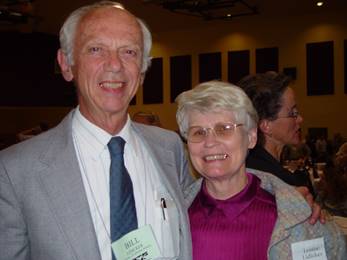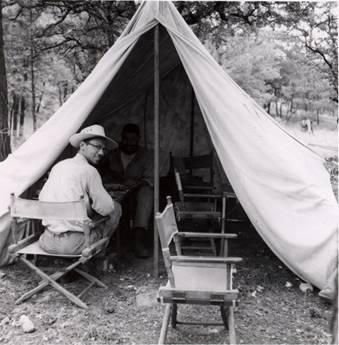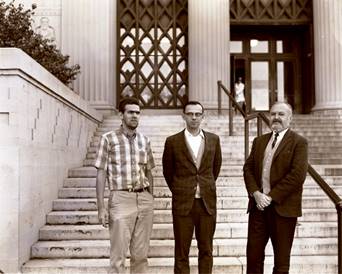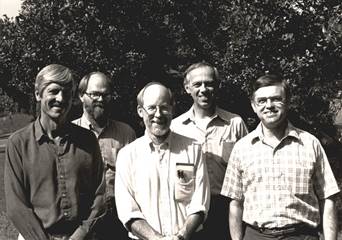It is our pleasure to introduce this Special Section of Therya in honor of the many professional and mammalogical accomplishments of Dr. William Z. (Bill) Lidicker, Jr. (Figure 1). Bill rocketed through his graduate career. After obtaining a BS from Cornell University in 1953, he began graduate studies at the University of Illinois Urbana-Champaign under the direction of Donald F. Hoffmeister. He completed his MS in 1954 and his PhD in 1957, both under the mentorship of Dr. Hoffmeister. He immediately took up a position as Instructor in Zoology and Assistant Curator of Mammals at the Museum of Vertebrate Zoology (MVZ), University of California, Berkeley, where he remained for his professional career. Influences on Bill’s early life leading him towards the study of natural history and mammals can be found in Layne and Hoffman (1994).

Figure 1 Bill and Louise Lidicker at the annual banquet of the 2004 meeting of the American Society of Mammalogists. Photo by Robert M. Timm.
Bill must have been a good Instructor because he was subsequently hired as an Assistant Professor at Berkeley in 1959. Most of his publications in graduate school were natural history observations, but he soon focused more on studies of small mammal systematics, including detailed analyses of intraspecific variation (e. g., Lidicker 1960) and cogent discussion of the concept of subspecies (e. g., Lidicker 1962a, reprinted in anthologies in 1970 and 1976). His taxonomic research at this time included descriptions of two new subspecies. During his time as an Assistant Professor, Bill also participated in an expedition to Mexico with other colleagues from MVZ (Figure 2).

Figure 2 Bill Lidicker in the field in Chihuahua, Mexico in 1961, preparing museum specimens. Photo by Ned K. Johnson, used with the permission of the Museum of Vertebrate Zoology, University of California, Berkeley.
Bill’s career at MVZ went straight up. He became Associate Professor and Associate Curator of Mammals in 1965, then full Professor and Curator in 1969. Along the way he did terms as Vice Chair of the Department of Zoology and Associate Director of MVZ (Figure 3). Bill’s research interests at this time became more focused on population ecology, social behavior, population genetics, and conservation. Starting with a seminal paper on emigration (Lidicker 1962b; see Krebs 2021 in this section), he developed a long-standing interest in small mammal social organization and dispersal, co-editing two books on the latter (Lidicker and Caldwell 1982; Stenseth and Lidicker 1992). Lidicker (1975) introduced the concept of presaturation dispersal. At the time, most ecologists thought of dispersal as increasing with population density, but Bill noted that in many cyclic populations, per capita dispersal actually peaked during the increase (suggesting it was an adaptive behavior), and declined at peak densities when habitats were saturated with individuals.

Figure 3 Bill as a faculty member at MVZ in 1967-68. At this time, Bill was Vice Chair of the Department of Zoology, and then Associate Director of the MVZ. From left: R. Bruce Bury, Bill Lidicker, Frank Pitelka. Dr. Pitelka was a strong influence encouraging Bill towards studying ecology and population dynamics. Photo by Elmer C. Aldrich, used with the permission of the Museum of Vertebrate Zoology, University of California, Berkeley.
Bill was (and is) fundamentally a systems biologist, a rare species of scientist in the realm of population biology. Some of his early field studies documenting that populations of California voles (Microtus californicus) varied more than two orders of magnitude from year to year impressed on Bill the need to understand the underlying causes of such fluctuations. Bill’s interests in this topic developed while broader debates raged among ecologists regarding whether animal populations were regulated by extrinsic factors (e. g., weather), or intrinsic factors (e. g., agonistic behavior), or even at all. To Bill, the answer to these questions was, “yes”. Bill defined the phenomenon to be explained - patterns of variation in abundance - in a broad, inclusive way and sought answers in a similar, diverse set of factors (i. e., a multifactorial approach to population dynamics; Lidicker 1988, 1991). He recognized features of the ecological systems in which voles were embedded that later became essential elements of theory on complex adaptive systems, including nonlinear relationships between variables, hierarchical organization, emergent properties, feedback loops, and the lack of equilibria. The conceptual models he described verbally and graphically were criticized as being untestable, yet Bill recognized that empirical tests were valid even if they evaluated only a few components at a time.
It is not surprising that Bill’s interests would turn to landscape ecology and spatial relationships among habitats during his time as Curator of Mammals (along with Jim Patton) in the 1980s (Figure 4). Bill’s spatial memory was legendary among his students at the time. Before the advent of personal computers and PDFs, professors tended to accumulate large libraries of reprints. Every flat surface in Bill’s office was covered with tall stacks of reprints, some stacks perhaps a meter tall. However, whenever a student stopped by to discuss a scientific problem, Bill could pull just the right reference out of the middle of one of these stacks, a feat that could have stumped Google. We all worried, however, that if there ever was an earthquake (this was the Bay Area after all), we would all have to rush to his office to dig him out from under a mountain of paper.
Bill’s contributions to landscape ecology include highlighting the value of landscape approaches for conserving vulnerable mammal species from habitat disruption (Lidicker 1995). His work on mammals has yielded many insights into factors that affect the demography and dynamics of small, vulnerable populations (Lidicker 2002). His interest in dispersal logically led to an interest in the influences of spatial relationships among habitat patches (Lidicker 2000), edge effects (Lidicker 1999), and particularly the ecology of wildlife corridors (Hilty et al. 2019).
Although Bill sometimes published synthetic commentaries, after around 2000 he began to publish more frequently on subjects related to the history and philosophy of science (we count at least 11 that could be classified accordingly from a recent CV). One of his most recent papers, for example, warns once again of the likely negative consequences of human population growth from both scientific and social perspectives (Lidicker 2020). Over his career, Bill has published more than 170 scientific papers, including editing or co-editing five books. He has mentored 13 MA students, 24 PhD students, and two postdocs (Figure 5). Bill also played a key role in training students when he co-sponsored Berkeley’s first-ever course in conservation biology, beginning in 1987, a popular subject that resonated strongly with young academics.
Bill has had a long-standing association with the American Society of Mammalogists. In addition to serving on numerous standing committees over the years, he has been a member of the Board of Directors since first being elected to that position in 1967. He was elected Vice President in 1974-76, then President in 1976-78. He received the C. Hart Merriam Award in 1986 in recognition of his long-term contributions to mammalian research, and was made an Honorary Member of the Society, ASM’s highest honor, in 1995. A few other notable honors include election as a Fellow of the California Academy of Science in 1969, as a Fellow of The Explorer’s Club (current members include Elon Musk, Jeff Bezos, and Sir Richard Branson) in 1979, and as a Fellow of the American Association for the Advancement of Science in 1986.
Bill’s contribution to international mammalogy has been substantial. Bill attended a symposium in Brno, Czechoslovakia, that preceded the first International Theriological Congress (ITC-1), which took place in Moscow, USSR, in 1974. These congresses were organized by the Steering Committee for the Section of Mammalogy (Theriology) within the International Union of Biological Sciences (IUBS) and take place every four years. Bill has attended all congresses since then. At the 8th Congress in 2001 in South Africa the name was changed to International Mammal Congress (IMC) to better reflect the International Federation of Mammalogists (IFM), which was responsible for holding each congress. Bill was elected President of IFM (2005 - 2009), and with Lynne Selwood (IFM Secretary), and Takashi Saitoh (IFM Treasurer), produced the Constitution and bylaws for IFM. Bill also presided over IMC-10 held in Mendoza, Argentina during 2009. Bill published an article describing IFM in the journal Therya (Lidicker 2011).

Figure 4 Curators of the Museum of Vertebrate Zoology, 1983. This era was the pinnacle of Bill’s career, as his lab in the 1980s included such notables as Rick Ostfeld, Ramone Baccus, David Ribble, Bill Laurance, Ed Heske, and a bit later, Felicia Keesing. All, coincidentally, contributors to this Special Section! From left: Ned Johnson, Harry Greene, Jim Patton, Bill Lidicker, David Wake. Photographer unknown, used with the permission of the Museum of Vertebrate Zoology, University of California, Berkeley.
Bill was a key person in the “birth” of Therya. When the Therya project began, many people thought it was a crazy idea to create a new journal, especially because the Asociación Mexicana de Mastozoología was small, had no budget for such a project, and two previous journals had failed. However, the proponents noted an absence of possibilities for publishing interesting topics about mammals mainly by Latin American authors. Concerns included the need for manuscripts to be reviewed by an “English speaker”, publication costs, and the necessity of a double blind evaluation system. At the time, Bill was part of the “Buddy System” of the ASM, a group of volunteers who assist mammalogists for whom English is not their native language improve the writing in manuscripts submitted to the Journal of Mammalogy, and agreed with these points among others. Therya invited and began to receive manuscripts at the end of 2009, and published its first issue in 2010. Bill was one of the original six editors and a great supporter of the project. Therya began as an electronic journal, since the added labor and expense of printing hard copies was a cause of the failure of the previous journals. Bill pushed very hard for the development of Therya, and served as an associate editor for seven years. He was Special Editor for the conservation issue (2015 vol. 6:1), which was the first issue of Therya that included papers with topics and authors from all continents, and has contributed several articles and letters to the editor himself. Bill has been one of the strong pillars on which Therya was been able to depend in order to achieve the growth and development that it has accomplished.

Figure 5 Field trip to Hastings Reservation, Carmel, California, in 1988 to monitor small mammal populations. From left: Back row - Bill Lidicker, Francis Villablanca, Bernie Peyton, Alex Yu, David Ribble; Front row - Susie Peyton, Yulan Chien, Warren Hayes, Marco Salvioni (postdoc from Switzerland). Photographer unknown, photo provided by David O. Ribble.
We would be remiss to fail to mention one of Bill’s other interests: international folk dancing. For many summers, Bill and Louise led classes and performed in tours, particularly in Eastern Europe. We’ve heard it said that he could out-dance others a third his age. He even wrote a paper on dancing by (non-human) mammals, published in Therya (Lidicker 2019). Bill was elected a Foreign Member of the Polish Academy of Sciences in 2000, and awarded their 50th Anniversary Medal in 2004. We are sure this was totally based on scientific merit and folk-dancing skills had nothing to do with it.
Congratulations, Bill. Long may you run!











 nova página do texto(beta)
nova página do texto(beta)


